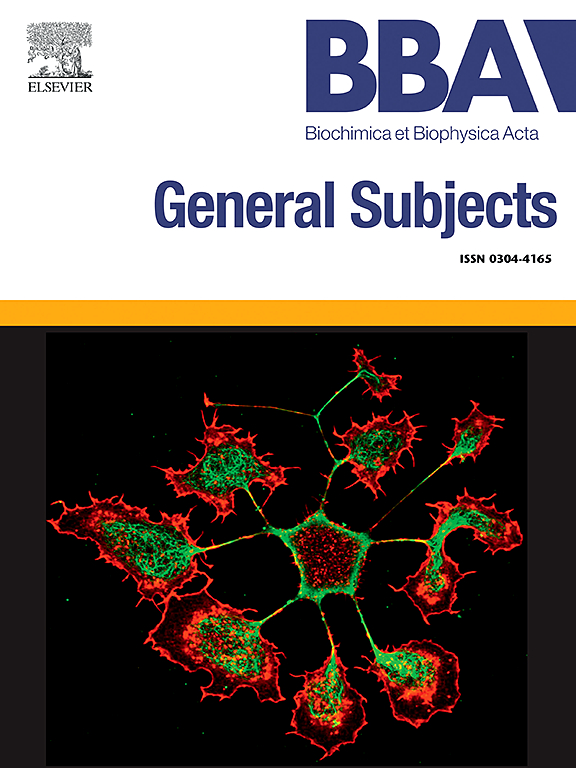Chloroplast arrangement in finger millet under low-temperature conditions
IF 2.2
3区 生物学
Q3 BIOCHEMISTRY & MOLECULAR BIOLOGY
Biochimica et biophysica acta. General subjects
Pub Date : 2025-01-06
DOI:10.1016/j.bbagen.2025.130757
引用次数: 0
Abstract
Background
Finger millet, a C4 plant with mesophyll and bundle sheath cells, has been cultivated at high altitudes in the Himalayas owing to its adaptability to stressful environments. Under environmental stresses such as high light and drought, finger millet mesophyll chloroplasts move toward the bundle sheath, a phenomenon known as aggregative arrangement.
Methods
To investigate the effect of low temperatures on mesophyll chloroplast arrangement in finger millet, we conducted microscopic observations and photochemical measurements using leaves treated at different temperatures in light or darkness, with or without pharmacological inhibitors. Abscisic acid (ABA) content was also quantified.
Results
Chloroplast aggregative arrangement was induced at 5 °C in a light- and actin-dependent manner. This response required a lower intensity of blue light than that previously observed at moderate temperatures. Low temperature significantly reduced the maximum quantum efficiency of photosystem II and increased leaf ABA content in the light. Conversely, in the absence of blue light at low temperatures or under actin-inhibited conditions, mesophyll chloroplasts exhibited a doughnut-like arrangement, characterized by a distribution away from the bundle sheath side.
Conclusions
In finger millet, mesophyll chloroplasts move toward the bundle sheath through a blue light and actin-based mechanism at low temperatures. The doughnut-like arrangement appears to be a contingent phenomenon that manifests when the dispersion of mesophyll chloroplasts toward the bundle sheath is impeded.
General significance
The aggregative arrangement is a response to various environmental stresses, including low temperatures, and may be advantageous for finger millet seedlings in mitigating photoinhibition during cool mornings.
低温条件下谷子叶绿体排列。
背景:谷子是一种具有叶肉和束鞘细胞的C4植物,由于其对应激环境的适应性,在喜马拉雅山的高海拔地区被种植。在强光和干旱等环境胁迫下,谷子叶肉叶绿体向束鞘移动,这种现象被称为聚集排列。方法:为了研究低温对谷子叶肉叶绿体排列的影响,我们对不同温度下的谷子叶片进行了显微镜观察和光化学测量,分别在光照和黑暗条件下处理,使用或不使用药物抑制剂。测定脱落酸(ABA)含量。结果:在5 °C条件下,叶绿体以光依赖性和依赖于动作蛋白的方式发生聚集排列。这种反应所需的蓝光强度比之前在中等温度下观察到的要低。低温显著降低了光系统II的最大量子效率,增加了叶片在光照下的ABA含量。相反,在低温或肌动蛋白抑制条件下没有蓝光的情况下,叶肉叶绿体呈现甜甜圈状排列,其特征是远离束鞘侧分布。结论:在低温条件下,谷子叶肉叶绿体通过蓝光和肌动蛋白机制向束鞘移动。甜甜圈状排列似乎是叶肉叶绿体向束鞘分散受阻时出现的偶然现象。总体意义:聚集排列是对各种环境胁迫的反应,包括低温,并且可能有利于手指谷子幼苗在凉爽的早晨减轻光抑制。
本文章由计算机程序翻译,如有差异,请以英文原文为准。
求助全文
约1分钟内获得全文
求助全文
来源期刊

Biochimica et biophysica acta. General subjects
生物-生化与分子生物学
CiteScore
6.40
自引率
0.00%
发文量
139
审稿时长
30 days
期刊介绍:
BBA General Subjects accepts for submission either original, hypothesis-driven studies or reviews covering subjects in biochemistry and biophysics that are considered to have general interest for a wide audience. Manuscripts with interdisciplinary approaches are especially encouraged.
 求助内容:
求助内容: 应助结果提醒方式:
应助结果提醒方式:


